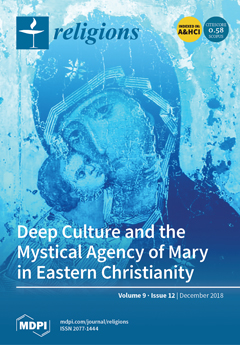This article examines the everyday religious phenomenon of
nirguṇa bhakti as it is experienced by Hindu renouncers (
sādhus) in North India. As an Indian language concept,
nirguṇa bhakti characterizes a type of devotion (
bhakti) that is expressed in relation
[...] Read more.
This article examines the everyday religious phenomenon of
nirguṇa bhakti as it is experienced by Hindu renouncers (
sādhus) in North India. As an Indian language concept,
nirguṇa bhakti characterizes a type of devotion (
bhakti) that is expressed in relation to a divinity who is said to be without (
nir) the worldly characteristics and attributes of sex and gender, name and form, race and ethnicity, class and caste. Although
bhakti requires a relationship between the devotee and the deity, the
nirguṇa kind transcends the boundaries of relational experience, dissolving concepts of “self” and “other”, and, in effect, accentuating the experience of union in the divine absolute. In comparison to
saguṇa bhakti (devotion to a deity with attributes),
nirguṇa bhakti is considered to be difficult to realize in human birth. Yet, the poetry, songs, and practices of uncommon humans who have not only left behind social norms, but also, devoting their lives to the worship of the divine, achieved forms of divine realization, people like the mystics, saints and
sādhus of Hindu traditions, laud the liberating power and insights of
nirguṇa bhakti. The Hindu
sādhus featured in this article describe their experiences of
nirguṇa bhakti through the use of the idiom of a “one-hundred rupee note” to distinguish its superior value and, as significantly, to indicate that humans “earn” God (Brahman) through the practice of
nirguṇa devotion. As a “precious” spiritual asset on the path of liberation,
nirguṇa bhakti establishes the religious authority and authenticity of
sādhus, while setting them apart from other
sādhus and holy figures in a vibrant North Indian religious landscape.
Full article





